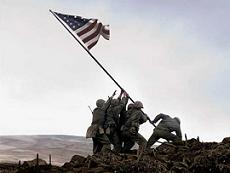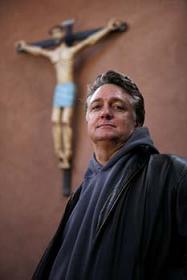 We like when things are neatly packaged and easily grasped, one character in Clint Eastwood’s “Flags of our Fathers” tells us: good and evil, heroes and villains. “Most of the time they aren’t. But we think they are.”
We like when things are neatly packaged and easily grasped, one character in Clint Eastwood’s “Flags of our Fathers” tells us: good and evil, heroes and villains. “Most of the time they aren’t. But we think they are.”
The movie, opening today, shows us the complex and messy depiction of the Battle of Iwo Jima. More importantly, it explores what was happening on the home front in the weeks while the battle still raged but a single photograph from its early days had galvanized the nation.
We tend to assume that that iconic photo–of six men hoisting the American flag on newly captured enemy territory–marked the end of the battle to take a small Pacific island called Iwo Jima. But that’s just one of the widely held assumptions shattered by “Flags of Our Fathers,” a haunting exploration of what it means to be a true hero, what it means to be a media- and government-created hero, and what it means to be an actual, three-dimensional human being who is seen by millions as a hero.
The neat and easy story goes like this: Soldiers heroically and victoriously hoist flag, giving hope to millions of Americans. “Flags of Our Fathers” presents the messy truth of it all. The photo was taken on Day 5 of what would be a 35-day battle, which, like all battles, saw confusion, horrific injuries, friendly-fire casualties, amazing feats of courage, occasional moments of cowardice, and inevitably, a death count too-high and too-grisly to contemplate.
But the moment the photo hit newspapers, it immediately became the iconic shot of World War II, and the government–broke and dispirited–new it had a winner. Though there was some confusion about just who was in the photo and which flag-raising was being celebrated (since there were two, the second done for petty reasons), the soldiers caught on film became instant celebrities. They were flown out of the battle zone to be wined and dined around the U.S. as they raised money for much-needed war bonds; this despite the fact that, in one soldier’s words, “It’s hard not to be called a hero for saving someone’s life. But for putting up a pole?”
The movie jumps back and forth between Iwo Jima and the U.S., where we follow three soldiers–the others in the photo had been killed–as they’re trotted out for audiences across the country, including one cringe-inducing re-creation of the famous flag-raising scene, complete with fireworks. Meanwhile, the soldiers must grapple with their guilt at being pulled away from their comrades while the battle rages on, their guilt at living while so many died, and their guilt at being called heroes when, in their eyes, the real heroes were those soldiers who died for their country. And, of course, they must cope with the horrific memories of what they saw there.
In truth, the soldiers were treated neither as heroes nor as icons. One was Native American, and faced discrimination and segregation despite his supposed “heroism.” All were dropped like yesterday’s news when they were no longer needed for the war-bond tour. The soldiers in that photograph should have been a symbol of all the heroism on Iwo Jima and throughout the U.S. military, but in the eyes of the public, it became the fame itself of being in that photo that mattered; when the soldiers tried to explain what really happened there, or when it was discovered that a particular dead soldier was not the one with his back turned in the photo, the public turned away, from the soldiers and their families, not caring about anything but to be part of the good feeling and get their own photos taken with the famous men. It was celebrity culture at its worst.
Many critics rightly see the movie as a comment on how governments package and sell wars, a message with obvious relevance to day. But “Flags” is as much, if not more, about us–how we fuel and react to fame and celebrity, how we choose and treat our supposed “heroes,” and how easy it is to lose sight of such things as truth and values when a presented with a simple, easy-to-digest narrative by the media and/or the government.
Though it is too long and too preachy–Eastwood spends far too much time “telling” and not enough time “showing” us how to feel–“Flags” is a brave and important movie. Despite its shortcomings, its message is one we’d all do well to contemplate in a culture so focused on celebrity, fame, and media-created “heroes.”


